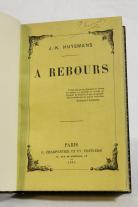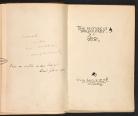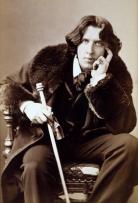Oscar Wilde's Love Affair with A Rebours
Created by Snag Flynn on Wed, 04/28/2021 - 02:09
A brief timeline of the history between J.K. Huysmans's novel A Rebours and the work of Oscar Wilde
Timeline
Chronological table
| Date | Event | Created by | Associated Places | |
|---|---|---|---|---|
| May 1884 |
A Rebours is PublishedA Rebours (Against the Grain), an aesthetic novel written by the French author Joris-Karl Huysmans (1848-1907), is published in 1884. Husysmans was a popular poet and well known writer of naturalism; A Rebours was Huysmans's first venture into aestheticism and swiftly aligned him with the growing movement of French Decadents. The novel follows a young aristocrat named Jean Des Essientes who retreats from busy city life to a home in the country to spend the rest of his days pursuing aesthetic philosophy. The novel contains waxing descriptions of a multitude of surrealist experiences, including the death of a tortoise and the blooming of a garden. A Rebours also contains descriptions of several prominent works of art, including French symbolist artist Moreau's Salome Dancing before Herod. |
Snag Flynn | ||
| Jul 1890 |
A Picture of Dorian Gray is PublishedIn July of 1890, Oscar Wilde published A Picture of Dorian Gray for the first time in Lippincott's Magazine. Lippincott's was a prominent literary publication from which WIlde had been denied in the past. The novel follow the life and downfall of a young man named Dorian Gray. Gray befriends a painter and falls in with a lazy bourgeois cast of hedonistic characters. A point in Gray's corruption is punctuated by the gift of a novel from one of his mentors; a small yellow book that ruins what's left of Dorian's conscious. The yellow book is apparently confirmed by Wilde to be a thematic allusion to Huysmans's A Rebours in Richard Ellman's biography of Oscar Wilde. |
Snag Flynn | ||
| Feb 1893 |
Salome is PublishedSalome was already in rehearsals for a 1892 London premiere, but was banned by the Lord Chamberlain's Office for its portrayal of BIblical figures on stage. In 1893, the play was published in its original French. Wilde is quoted as having said to an interviewer with the Pall Mall Gazette in 1892, "My idea of writing the play was simply this: I have one instrument that I know I can command, and that is the English language. There was another instrument to which I had listened all my life, and I wanted once to touch this new instrument to see whether I could make any beautiful thing out of it". Salome follows the step-daughter of King Herod (named Salome, if you couldn't guess). She performs a dance for King Herod, the Dance of Seven Scarves, and afterwords she requests the head of John the Bapitist on a silver platter. The main focus of the play was the dance, in which seven silk scarves work as extensions of the performers body. The sexuality of Wilde's version of Salome's dance differs greatly from that mentioned in the New Testament. This is believed to be directly linked to Huysmans writing about the story of Salome in A Rebours. Huysmans's surrealist interpretation of Salome's performance for Herod is brought to life via Wilde's script. |
Snag Flynn | ||
| Apr 1895 to May 1895 |
Trials of Oscar WildeWilde is brought to court in April of 1895 on charges of gross indecency. During the trial, Wilde's affinity for Huysmans's A Rebours is brought as evidence against his character. A specific passage in A Rebours in which Huysmans alludes to multiple places homosexual men were known to meet-up through-out Paris is used against Wilde in court; in A Rebours, Huysmans suggests a sexual relationship between the protagonist, Des Esseintes, and a young man he meets asking directions towards Rue de Babylon. During trial, Wilde denies the yellow book given to Dorian by Lord Henry in his novel is A Rebours, even to the point of including purposefully incorrect chapter references, but the description in the text makes very clear exactly what French novel unravels Dorian's conscious. Wilde is sentenced to two years of hard labor. |
Snag Flynn |




